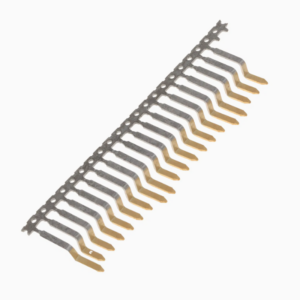Deep Drawing of Sheet Meta
Top Metal Stamping specializes in custom manufacturing, particularly in stamped and deep-drawn parts. Our advanced factory and experienced team offer design support and in-house tooling capabilities, ensuring cost-effective solutions for complex parts in any quantity. With a focus on precision and quality, we've been a trusted industry leader since 2005, continuously refining our deep drawing stamping expertise to serve various industries. Let us help you with your next project by sharing our extensive knowledge and providing innovative solutions
Common Deep Drawing Application
The deep drawing process is used to manufacture a huge range of components that are used for many purposes in a variety of industries. These include:
- Aerosol mounting caps
- Battery cases
- Blasting caps
- Buttons
- Canisters
- Cans
- Connectors
- Cups
- Electrode tips
- Eyelets
- Fasteners
- Ferrules
- Grommets
- Housings
- Light bulb screw shells
- Lipstick cases
- Munitions
- Rivets
- Shells
- Sleeves
- Tubes
The Benefits of Deep Draw Stamping
Deep draw stamping is optimal for products that require water-tight or air-tightness, (there are no seams), significant strength, and minimal weight. Often, it is the most effective way to form products that have unconventional or difficult geometries. In terms of production logistics, deep draw stamping provides many benefits:
• Increased productivity
Draw speeds are limited only by the contact velocity required by the material. If multiple draws are required to produce the finished draw, they can be performed simultaneously in stations of a transfer or progressive die, optimizing cycle times. If you have large-volume needs and want to keep costs down, these rapid cycle times are an efficient way to go.
• Lower initial costs
Deep draw metal stamping provides cost-effective production of complex components with reduced material waste and enhanced efficiencies. Tooling costs are lower, typically requiring only one set of durable and renewable tool steel or carbide dies, minimizing the need for re-tooling.
• High Precision
The controlled deformation of metal sheets ensures consistent and accurate part dimensions, meeting the most stringent quality requirements.
• Exceptionally strong parts
Deep draw stamped parts are stronger and more durable due to cold-working, which improves mechanical properties and resistance to wear, corrosion, and fatigue. The process maintains an elongated and cohesive grain structure throughout the part, ensuring strength, while also increasing hardness and tensile strength.
• Metal diversity
A wide range of metals can be deep drawn, providing a number of manufacturing options. The most common metals include mild steel, stainless steel, aluminum, copper, and brass. A knowledgeable stamper should be able to offer assistance in choosing the best material or alloy for your application.
Common Industries for Metal Terminals
Metal Terminals are found throughout many applications. Here are some common industries where Terminals are used:
- Automotive
- Industrial
- Construction
- Aerospace
- Appliance
- Medical
- Electronics
- Lighting Industry
- Renewable Energy
Types of Deep Drawing
Deep drawing comes in various types, each with its benefits and material suitability:
Conventional Deep Drawing: Involves pushing a flat metal sheet into a die cavity using a punch, forming the desired shape seamlessly.
Progressive Deep Drawing: Utilizes multiple dies to gradually form the part as the blank passes through different stations, suitable for complex shapes requiring various forming steps.
Tandem Deep Drawing: Similar to progressive but uses multiple blanks simultaneously, allowing for parallel production and increased output.
Reverse Deep Drawing: Also known as negative drawing, involves drawing a pre-formed shell or cup into a die to create deeper components with smaller openings, ideal for containers and housings.
Compound Deep Drawing: Simultaneously uses different dies and punches to create parts with intricate designs.
Hydroforming: Specialized method for creating deep-formed metal stampings, particularly useful for unconventional shapes found in structural and automotive applications.
POST-STAMPING OPERATIONS
In addition to our manufacturing capabilities, we provide a range of post-production processes to ensure the completion of finished parts before packaging and delivery. These operations include
Anodizing
sandblasting
painting
powder coating
plating
silk printing
brushing
polishing,
laser engraving
MATERIALS
High carbon steel
Low carbon steel
Stainless steel
Cold rolled steel
Brass
Beryllium copper
Phosphor bronze
Aluminum
Nickel
PLATING MATERIAL FINISHES
We provide various pre- and post-plating options for metal stamping assemblies to allow for corrosion protection, electrical conduction, decorative use, wear resistance, coloring, bonding, and lubricity. You can choose between overall plating, select plating, or spot plating application. Plating material finishes include:
Copper
Nickel
Tin-Lead
Tin
Palladium
Palladium-Nickel
Silver
Gold
Zinc
STAMPING ASSEMBLY HARDWARE AND PART INSTALLATIONS
For assembled applications, parts may require joining of metal hardware, plastic parts or metal inserts. Examples of assembly hardware and part installations are:
Plastic Pieces
Metal Inserts
Fasteners
Screw Machine Parts
Bushings
Nuts
Studs
The Process For Packing
Carton
Wooden case
Wooden pallet
Plastic pallet
Wire basket
Woven bag
Dedication to Quality
Our unwavering commitment to quality underscores our dedication to meeting and exceeding our customers' expectations. We strive to enhance customer satisfaction by continually enhancing our products, processes, services, and quality management system. Demonstrating our steadfast dedication to quality, we employ a range of testing and inspection methodologies, including:
Failure Mode and Effects Analysis (FMEA) to prevent potential failure points.
Adherence to the rigorous Production Part Approval Process (PPAP) for stringent compliance standards.
Implement Advanced Product Quality Planning (APQP) to ensure production stability and consistency.
Moreover, our certification under ISO9001 and IATF 16949:2016 underscores our commitment to delivering precise, high-quality products, further instilling confidence in our customers



